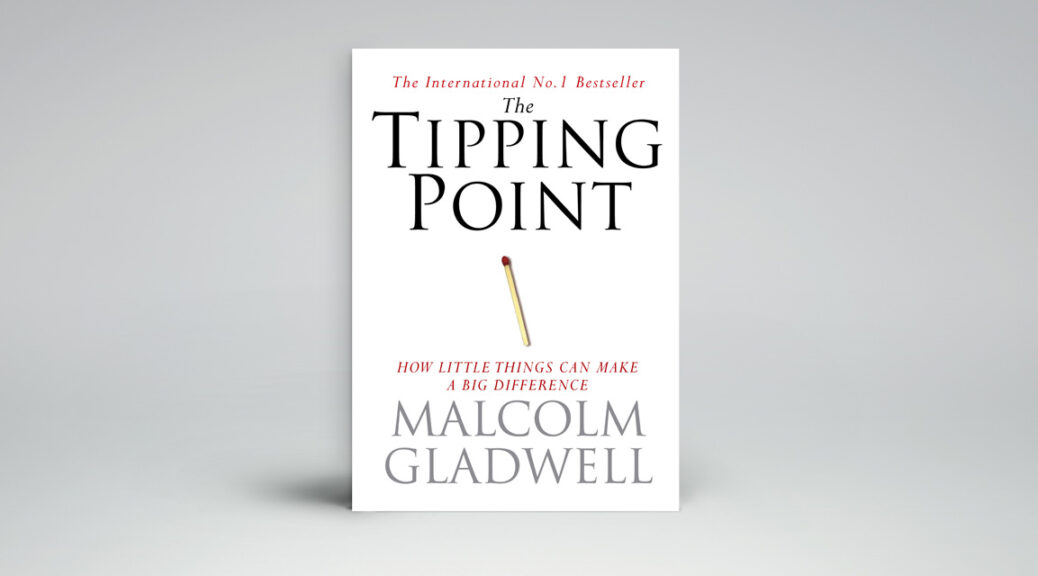
The Tipping Point – How Little Things Can Make A Big Difference by Malcolm Gladwell
First of… this is his first book… I’ve reviewed the others already. Man this book has lots to take in. It’s is about the little things that cause drastic changes. Analysing the ‘point’ where the scales ‘tip’ so to speak. And the case studies go deep and for these epidemics to take place you need 3 things…
1 – The Law of the Few,
2 – The Stickiness Factor,
3 – The Power of Context.
For the law of the few we have
– Mavens: are the people that have a need to know, need to help, need to solve others problems, the one’s you’d go to for information about anything, sharing knowledge and skills… the ones that start the word-of-mouth epidemics.
Amazon #ads
– Connectors: they’re the ones that get people together, the schmoozers, the networkers.
– Sales people: these guys have skills in persuasion, charisma, all those good things to convince you, to have you agreeing away at what they say.
Malcolm introduces the Tipping Point with a story of Hush Puppies (shoes) and how just a few cool kids turned them into the in thing. Then he goes over to how crime in New York reduced so drastically just by cleaning up graffiti and being strict on the train fares and stuff like that. Tipping points of how faxes sold like crazy and how cell phones followed suit. How the number of role models in places affected pregnancy and drop-out rates. You know how when it snows, in the start it’s still not too cold and you have fun and all…. then the cold kicks and does not go away? That’s another tipping point.
He goes on to the story of crack addicts and AIDS/syphilis and how it was connected to the Economists 80/20 principle where 80% of the STD spreading is done by 20% of the infected. Then goes on to the 6 degree of separation stuff and how advertisers try to get you nodding by having bouncy balls on the screen and such, since it changes how the viewer feels about the product. What senders are. It goes deep into what kids like to watch… how Sesame Street became an educational hit when most experts said TV would not work on kids. How Blue’s Clues took Sesame Streets good ideas and pushed it a step further by repeating the same episode the whole week. Unheard of in media! Recording kids self conversations with themselves and how much more intelligent they were compared to when they interacted with, say, parents. The broken window theory, like if you see a broken window it attracts the wrong people and soon it’s a house robbed.
The rule of 150 and how so many cultures had about that many people in a village. It’s the best number for groups. Gore-Tex thrived because of it. In fact I love Gore-Tex’s framework because nobody has a title in the company… they’re all just associates. Magic number 7 is about how that’s the average number that comes up for the main peeps in our lives no matter how many we know. How giving clean needles to drug addicts was a way to find a connector/sales person. See certain folks would come with bags of used needles to exchange for new ones… but these guys were selling them back to the addicts and how they used these needle retailers to spread the word for awareness and all the good stuff and make sure folks were getting high off clean needles. Now the trendsetting kids were more concerned about the bigger picture and activism while other kids were worried about smaller personal issues.
Over to a story of how one dude’s suicide dominoed a whole ‘suicide for recreation’ in Micronesia. Suddenly songs, t-shirts, graffiti… hyped suicide in their content. How the same story is connected to smoking. And lots of tests and experiments about chain smokers vs. chippers (light/social smokers). They found out heavy smokers are extrovert, short tempered, unreliable, have a higher sex drive and antisocial index, take more risks, spend more on coffee and beer and are more honest. Oh and if they stop smoking they hit depression, alcoholism and schizophrenia harder. So smoking is like a self treatment. There’s a bit on how medics realized some anti-depression drugs reduced the need for smoking too.
And finally a story of how a lady wanted to spread the word to black folks about diabetes and breast cancer but it didn’t work in church and how she found out her best way was through beauty salons and how they trained the stylists about it all. Really good book for those that want to tip their sales in business mostly. Big up Viv for yet another Malcolm Gladwell joint!
Amazon #ads
Contents:
– Introduction
– 1 The Tree Rules of Epidemics.
– 2 The Law of the Few: Connectors, Mavens, and salesmen.
– 3 The Stickiness Factor: Sesame Street, Blue’s Clues, and the Educational Virus.
– 4 The Power of Context (Part One): Bernie Goetz and the Rise and Fall of New York City Crime.
– 5 The Power of Context (Part Two): The Magic Number One Hundred and Fifty.
– 6 Case Study: Rumors, Sneakers, and the Power of Translation.
– 7 Case Study: Suicide, Smoking, and the Search for the Unsticky Cigarette.
– 8 Conclusion: Focus, Test, and Believe.
– Endnotes.
– Acknowledgements.
– Index.





